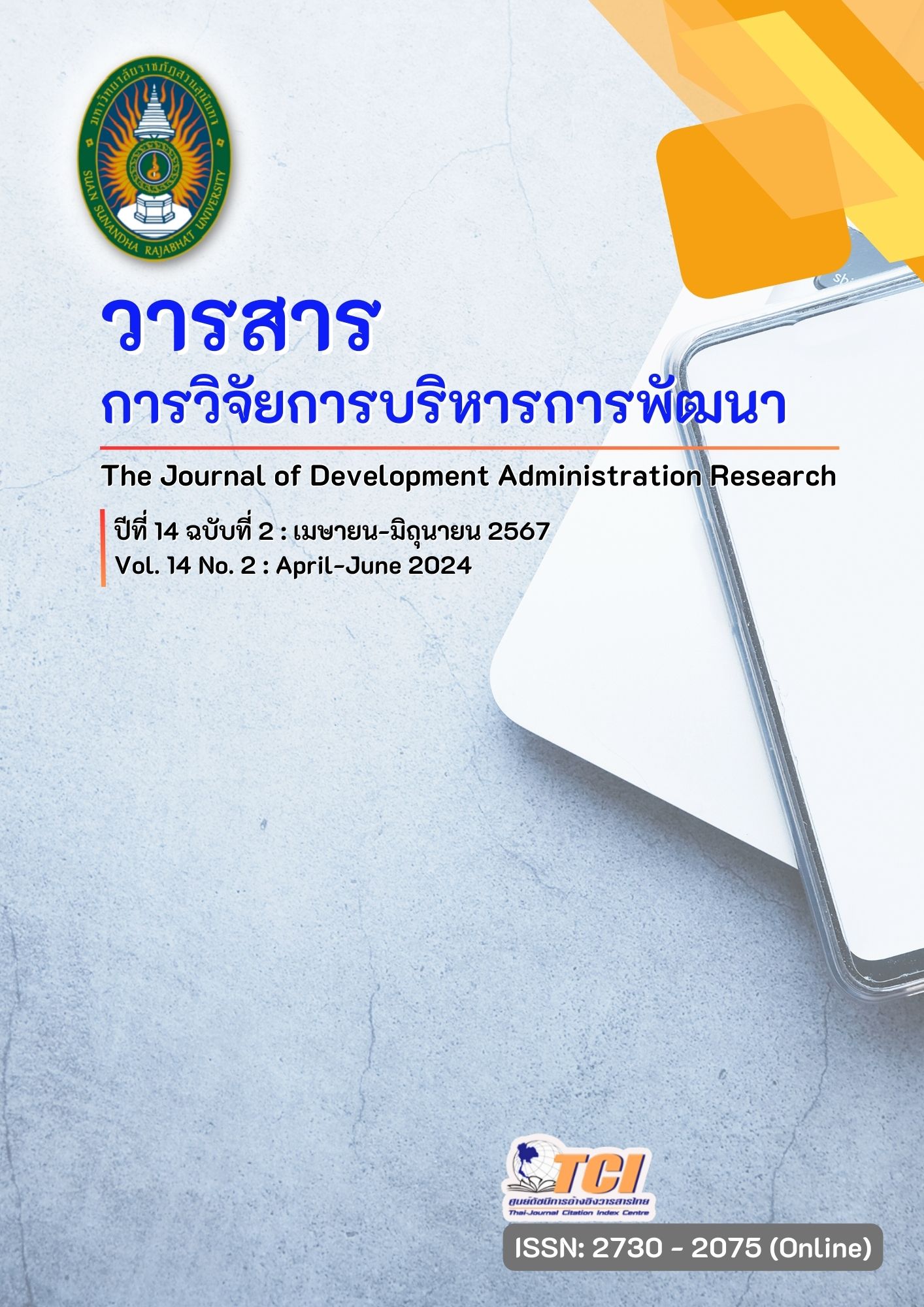โมเดลความสัมพันธ์เชิงสาเหตุของการตัดสินใจซื้อสินค้าผ่านแอปพลิเคชัน ของผู้บริโภคในกรุงเทพมหานคร
คำสำคัญ:
ส่วนประสมทางการตลาด, คุณภาพการให้บริการทางอิเล็กทรอนิกส์, ความไว้วางใจในการซื้อสินค้า, การตัดสินใจซื้อสินค้าผ่านแอปพลิเคชันบทคัดย่อ
การวิจัยนี้มีวัตถุประสงค์ เพื่อค้นหาโมเดลความสัมพันธ์เชิงสาเหตุของการตัดสินใจซื้อสินค้าผ่านแอปพลิเคชันของผู้บริโภคในกรุงเทพมหานคร ได้แก่ ส่วนประสมทางการตลาด คุณภาพการให้บริการทางอิเล็กทรอนิกส์ ความไว้วางใจในการซื้อสินค้า และการตัดสินใจซื้อสินค้าผ่านแอปพลิเคชัน เป็นการวิจัยเชิงผสมผสาน การวิจัยเชิงปริมาณกลุ่มตัวอย่าง ได้แก่ผู้บริโภคที่ซื้อสินค้าผ่านแอปพลิเคชันในกรุงเทพมหานคร จำนวน 400 คน เครื่องมือที่ใช้คือ แบบสอบถาม วิเคราะห์ข้อมูลโดยใช้สถิติ ค่าร้อยละ ค่าเฉลี่ยและส่วนเบี่ยงเบนมาตรฐาน และการวิจัยเชิงคุณภาพ ผู้ให้ข้อมูลคือ ผู้แทนจากหน่วยงานภาครัฐ จำนวน 5 ท่าน ผู้บริหารจากบริษัทหรือองค์กรที่เกี่ยวข้องกับธุรกิจการค้าออนไลน์ในประเทศไทย จำนวน 6 ท่าน และนักวิชาการหรือผู้เชี่ยวชาญด้านการการตลาดและบริหารธุรกิจในประเทศไทย จำนวน 6 ท่าน วิเคราะห์ข้อมูลด้วยการวิเคราะห์เนื้อหาและนำเสนอเชิงพรรณนา
ผลการวิจัย พบว่า โมเดลความสัมพันธ์เชิงสาเหตุของการตัดสินใจซื้อสินค้าผ่านแอปพลิเคชัน ส่วนใหญ่ผู้บริโภคใช้แพลตฟอร์อิเล็กทรอนิกส์ Lazada ซึ่งรูปแบบการจัดส่งผู้บริโภคยังใช้บริการผู้จัดส่งสินค้า
ของแพลตฟอร์ม ส่วนผลการวิเคราะห์โมเดลสมการโครงสร้างความสัมพันธ์ระหว่าง ส่วนประสมทางการตลาด คุณภาพการให้บริการทางอิเล็กทรอนิกส์ ความไว้วางใจในการซื้อสินค้า และการตัดสินใจซื้อสินค้าผ่านแอปพลิเคชันมีความสอดคล้องกับข้อมูลเชิงประจักษ์การพัฒนาโมเดลความสัมพันธ์เชิงสาเหตุของการตัดสินใจซื้อสินค้าผ่านแอปพลิเคชัน สามารถนำไปใช้ประโยชน์โดยการใช้เป็นแนวทางในการพัฒนาและเพิ่มประสิทธิภาพในการให้บริการด้านการขายสินค้าหรือบริการผ่านแอพปพลิเคชัน โดยพัฒนาช่องทางในการสื่อสารให้กับผู้บริโภคและใช้ในการวางยุทธศาสตร์ในการป้องกันกลุ่มมิจฉาชีพที่ส่งผลต่อการตัดสินใจเลือกซื้อสินค้าออนไลน์
เอกสารอ้างอิง
กระทรวงดิจิทัลเพื่อเศรษฐกิจและสังคม. (2565). รายงานผลการสำรวจพฤติกรรมผู้ใช้อินเทอร์เน็ตในประเทศไทย ปี 2565. สืบค้นเมื่อ 3 มีนาคม 2566, จากhttps://www.etda.or.th/getattachment/ 78750426-4a58-4c36-85d3-d1c11c3db1f3/IUB-65-Final.pdf.aspx
ธมกร แสงวงสว่าง และ เสาวลักษณ์ จิตติมงคล. (2564). กลยุทธ์การตลาดออนไลน์ที่ส่งผลต่อความสำเร็จทางการตลาดของธุรกิจผ้าพื้นถิ่นในภาคตะวันออกเฉียงเหนือ. วารสารมหาวิทยาลัยราชภัฏร้อยเอ็ด, 15(2), 154-167.
ธิคณา ศรีบุญนาค และอุมาพร พงษ์สัตยา. (2562). ส่วนประสมการตลาดที่ส่งผลต่อกระบวนการตัดสินใจซื้อ เครื่องสำอางเกาหลีผ่านแอพพลิเคชันออนไลน์. วารสารบริหารธุรกิจและสังคมศาสตร์: มหาวิทยาลัยรามคําแหง, 2(3), 88-100.
ธานินทร์ ศิลป์จาร. (2563). การวิจัยและวิเคราะห์ข้อมูลทางสถิติด้วย SPSS. พิมพ์ครั้งที่ 18. กรุงเทพฯ: บิสซิเนสอาร์แอนด์ดี.
พลอยณภา สัมมาทรัพย์, อิราวัฒน์ ชมระกา & กุลยา อุปพงษ์. (2566). ความสัมพันธ์เชิงสาเหตุระหว่างส่วนประสม ทางการตลาดออนไลน์ การรับรู้คุณค่า ความน่าเชื่อถือต่อตราสินค้า และความตั้งใจซื้อเฟอร์นิเจอร์ของลูกค้าในประเทศไทย. Journal of Business Administration and Languages (JBAL), 11(1), 87-102.
มนตรี พิริยะกุล (2564). การกำหนดขนาด ตัวอย่าง สำหรับการวิเคราะห์ตัวแบบสมการโครงสร้าง. The Journal of Industrial Technology, 17(3), 232-246.
สำนักทะเบียนกลาง. (2566). จำนวนราษฎรทั่วราชอาณาจักร ตามหลักฐานการทะบียนราษฎร. สืบค้นเมื่อ 14 ตุลาคม 2566, จาก http://203.155.220.118/green-parks-admin/reports/report_parks_ roof.php?park_year=2564
สุธาทิพย์ ทั่วจบ. (2562). พฤติกรรมการซื้อสินค้าผ่านแอปพลิเคชันออนไลน์ของนักศึกษาระดับปริญญาตรี อำเภอพุทธมณฑล จังหวัดนครปฐม. วารสารวิชาการ มหาวิทยาลัยกรุงเทพธนบุรี, 8(2), 195-205.
สุภมาส อังศุโชติ. (2015). การใช้เทคนิคการวิเคราะห์องค์ประกอบเพื่อพัฒนาเครื่องมือวิจัยทาง พฤติกรรมศาสตร์. Sripatum Review of Humanities and Social Sciences, 15(1), 125-135.
โสรญา จันทร์รักษา และ สุมามาลย์ ปานคำ. (2017, September). โมเดลความสัมพันธ์เชิงสาเหตุการ ตัดสินใจซื้ออาหารผ่านแอปพลิเคชัน Line Man ของผู้อยู่อาศัยในเขตกรุงเทพมหานคร และ ปริมณฑล. In Rangsit Graduate Research Conference: RGRC, 12, 1035-1044.
Ali, H., Zainal, V. R., & Ilhamalimy, R. R. (2021). Determination of Purchase Decisions and Customer Satisfaction: Analysis of Brand Image and Service Quality (Review Literature of Marketing Management). Dinasti International Journal of Digital Business Management, 3(1), 141-153.
Aryansah, I. (2013). Iklim organisasi dan kualitas kehidupan kerja karyawan. Humanitas, 10(1), 75.
Asdi, A., & Putra, A. H. P. K. (2020). The effect of marketing mix (4P) on buying decision: Empirical study on brand of Samsung smartphone product. Point Of View Research Management, 1(4), 121-130.
Athar, H. S. (2021). The impact of marketing mixes on the purchase decision when borrowing consumer loans. Amwaluna: Jurnal Ekonomi dan Keuangan Syariah, 5(1), 40-49.
Dapas, C. C., et al. (2019). The effect of service quality and website quality of zalora. Com on purchase decision as mediated by purchase intention. Calitatea, 20(169), 87-92.
Demir, A., et al. (2021). The role of E-service quality in shaping online meeting platforms: a case study from higher education sector. Journal of Applied Research in Higher Education, 13(5), 1436-1463.
Ding, L., Velicer, W. F., & Harlow, L. L. (1995). Effects of estimation methods, number of indicators per factor, and improper solutions on structural equation modeling fit indices. Structural Equation Modeling: A Multidisciplinary Journal, 2(2), 119-143.
Ginting, Y., et al. (2023). Repurchase intention of e-commerce customers in Indonesia: An overview of the effect of e-service quality, e-word of mouth, customer trust, and customer satisfaction mediation. International Journal of Data and Network Science, 7(1), 329-340.
Gronemus, J. Q., et al. (2010). Potent inhibition of the classical pathway of complement by a novel C1q-binding peptide derived from the human astrovirus coat protein. Molecular immunology, 48(1-3), 305-313.
Lazaroiu, G., et al. (2020). Consumers’ decision-making process on social commerce platforms: Online trust, perceived risk, and purchase intentions. Frontiers in Psychology, 11, 890.
Lee, T. H., Fu, C. J., & Chen, Y. Y. (2019). Trust factors for organic foods: consumer buying behavior. British Food Journal, 122(2), 414-431.
Marpaung, N. N. (2022). The Influence of The Marketing Mix on Buying Decision (Study on Rb Collection Pasar Baru Bekasi). International Journal of Education, Information Technology, and Others, 5(2), 166-176.
Maulana, S., & Najib, M. (2021). Analysis of the effect of marketing mix on consumer trust and satisfaction on online purchasing of organic food during the outbreak of the Covid-19. Jurnal Aplikasi Manajemen, 19(2), 257-271.
Mendoza, M. C. O., Santos, R. R. C., & Magdaraog, J. E. H. (2020). Assessment of E-service quality dimensions and its influence on customer satisfaction: a study on the online banking services in the Philippines. In 2020 IEEE 7th international conference on industrial engineering and applications (ICIEA) (pp. 1076-1081). IEEE.
Mitchell, R. J. (1992). Testing evolutionary and ecological hypotheses using path analysis and structural equation modelling. Functional Ecology, 123-129.
Qazzafi, S. H. (2019). Consumer buying decision process toward products. International Journal of Scientific Research and Engineering Development, 2(5), 130-134.
Setiawan, H., Hasyim, H., & Mutiara, R. (2020). Marketing Mix and Trust as A Visiting Intention Factors. Journal of Multidisciplinary Academic, 4(6), 373-380.
Shankar, A., & Datta, B. (2020). Measuring e-service quality: a review of literature. International Journal of Services Technology and Management, 26(1), 77-100.
Suksawang, N., Mirmiran, A., & Yohannes, D. (2014). Use of fiber reinforced concrete for concrete pavement slab replacement (No. BDK80 TWO 977-27). Florida. Dept. of Transportation. Research Center.
Teixeira, S., Sofia, A., & de Lima, A. P. (2023). The relationship of online trust with Consumer Generated Media. International Journal of Marketing, Innovation and Strategy, 1(1), 51-59.
ดาวน์โหลด
เผยแพร่แล้ว
รูปแบบการอ้างอิง
ฉบับ
ประเภทบทความ
สัญญาอนุญาต
ลิขสิทธิ์ (c) 2024 วารสารการวิจัยการบริหารการพัฒนา

อนุญาตภายใต้เงื่อนไข Creative Commons Attribution-NonCommercial-NoDerivatives 4.0 International License.
บทความที่ได้รับการตีพิมพ์เป็นลิขสิทธิ์ของมหาวิทยาลัยราชภัฏสวนสุนันทา
ข้อความที่ปรากฏในบทความแต่ละเรื่องในวารสารวิชาการเล่มนี้เป็นความคิดเห็นส่วนตัวของผู้เขียนแต่ละท่านไม่เกี่ยวข้องกับมหาวิทยาลัยราชภัฏสวนสุนันทา และคณาจารย์ท่านอื่นๆ ในมหาวิทยาลัยฯ แต่อย่างใด ความรับผิดชอบองค์ประกอบทั้งหมดของบทความแต่ละเรื่องเป็นของผู้เขียนแต่ละท่าน หากมีความผิดพลาดใดๆ ผู้เขียนแต่ละท่านจะรับผิดชอบบทความของตนเองแต่ผู้เดียว




